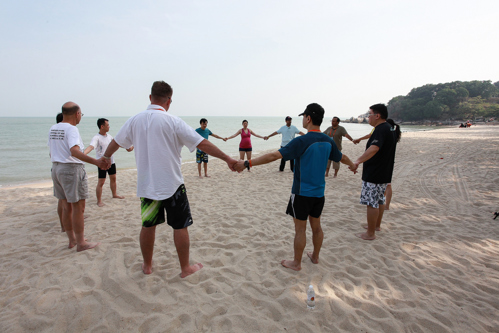How To Differentiate Between Innate Talent and Trainable Skill
January 29, 2025
Published in:
Leaders must understand the difference between innate ability and trainable skill, then hire and develop their team accordingly to deliver exceptional results. Use these action steps to create a world-class team in your organization.

Contributed by Robert Glazer, an EO Boston elumni who is the founder and board chair of Acceleration Partners, an award-winning global partner marketing agency. Glazer is the best-selling author of seven books and the inspirational Friday Forward newsletter, and hosts The Elevate Podcast. His posts for EO include How to Move Beyond Resolutions to Sustainable New Habits, Five No’s, How to Become a Feedback Champ, and The Excuse Leaders Must Remove From Their Vocabulary.
One important question every leader must ask is, “Where does my organization or team have a talent or skill problem?”
When building teams, one of the most important things leaders must do is differentiate between an innate talent and a trainable skill. But how do you do so?
Examples of Stellar Customer Service
Consider Southwest Airlines, which is known for their unique culture and award-winning customer service. To build a team of flight attendants who deliver world-class service and make customers feel comfortable, Southwest recruits funny, affable and service-oriented people, then trains them to be flight attendants.
Obviously, this strategy would fail in reverse: imagine if an airline hired experienced flight attendants and tried to train them to be funny or warm. It wouldn’t work—those are hard-wired traits or characteristics developed over decades.
I was reminded of this talent and skill distinction during a recent Backroads tour with several of my college friends and their spouses. Backroads is known for fun, outdoor activity-oriented trips and amazing customer service, exemplified by a 9.84/10 average trip rating. This was my second trip with them, and it was one of the most memorable weeks of my life, as it combined amazing service and time outdoors with lifelong friends.
Look for Innate Qualities You Cannot Teach
As I chatted with our tour leaders during the trip, it became evident that Backroads, like Southwest, understands the importance of both innate talent and trainable skills, and recognizes the difference between the two.
The leaders of my two Backroads trips each possessed two qualities that you cannot teach:
- They love the outdoors and adventure.
- They enjoy people and building community.
To that point, many Backroads leaders spend their time off doing the same things they do in their work: traveling, hiking and biking with friends. This exemplifies core value alignment.
Train for Necessary Skills
Of course, hiring people with the right innate qualities is just one part of the equation. The second is making sure they are equipped to do their best work through training, an area where Backroads is outstanding.
The week before we left for our trip, the Wall Street Journal happened to do a piece on Backroads’ training process, which includes a two-week onboarding bootcamp where new employees do simulations of many real scenarios trip leaders are likely to face. In talking with our trip leaders, I also learned about the company’s extensive multi-round interview process, which concludes with a group interview where candidates interact with other potential team members for an extended period, to assess their interpersonal aptitude.
Backroads’ training features other best practices I have observed at leading companies over the years. For example, many training scenarios are meant to empower the employee, teaching them to help customers solve problems with frameworks such as LAUGH: Listen, Acknowledge, Understand, Give Options, Hit Home Training. At the same time, training focuses on specific technical skills needed to solve problems that often occur on trips such as adjusting bike handlebars and fixing gears.
Finally, Backroads uses myriad processes to keep guests safe and on time, with many of those processes visible on checklists, van doors, and other prominent places. It was clear what processes trip leaders were expected to follow regularly, and which procedures they needed to share with our group each morning in our daily briefings.
3 Steps to Develop a World-Class Organization
If you want to have a world-class organization that tops your industry and wows your customers, try these steps:
1. Identify Innate Talents
Identify the immutable talents and values that prospective employees need to be successful, then design an interview method to identify those in the hiring process.
2. Provide Extensive Training
Train employees extensively, helping them develop the skills they’ll need on the job and giving them opportunities to practice the work they’ll do before they enter the field. This training should teach frameworks that empower employees to solve problems, rather than having to run to a supervisor whenever something goes wrong. Training should also equip them with specific skills that will be needed in their role.
3. Devise and Document Processes
Devise processes that ensure high-quality outcomes are delivered consistently and regularly revisit those processes to see if they can be improved.
What’s great about this formula is that it becomes a self-fulfilling flywheel: When you have the right people who are trained properly, customers will love the product or service and respond well. This in turn makes employees even more dedicated to their craft.
However, you need to enact all these steps in the correct order. Remember that all the training in the world won’t make an employee service-oriented, funny, and detail-oriented, and all the innate ability in the world won’t be enough without effective training, support, and processes.
This post first appeared on Robert Glazer’s Friday Forward newsletter and is reposted here with permission.